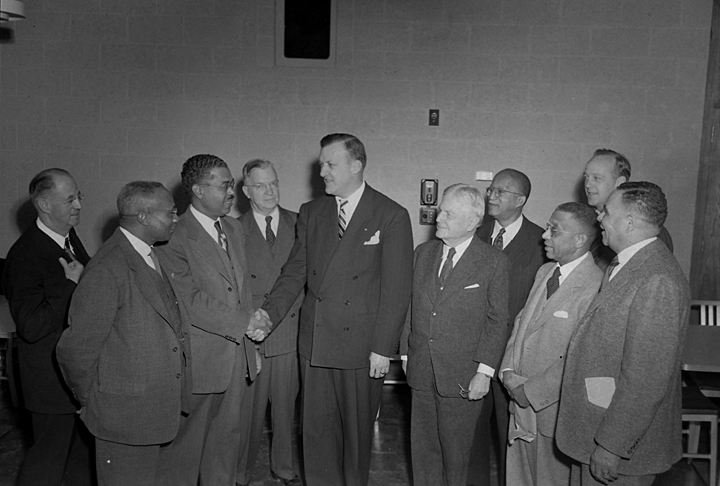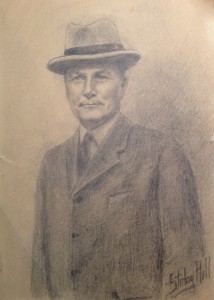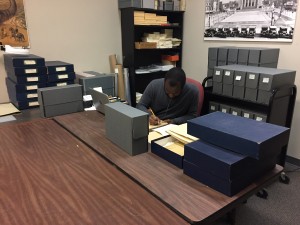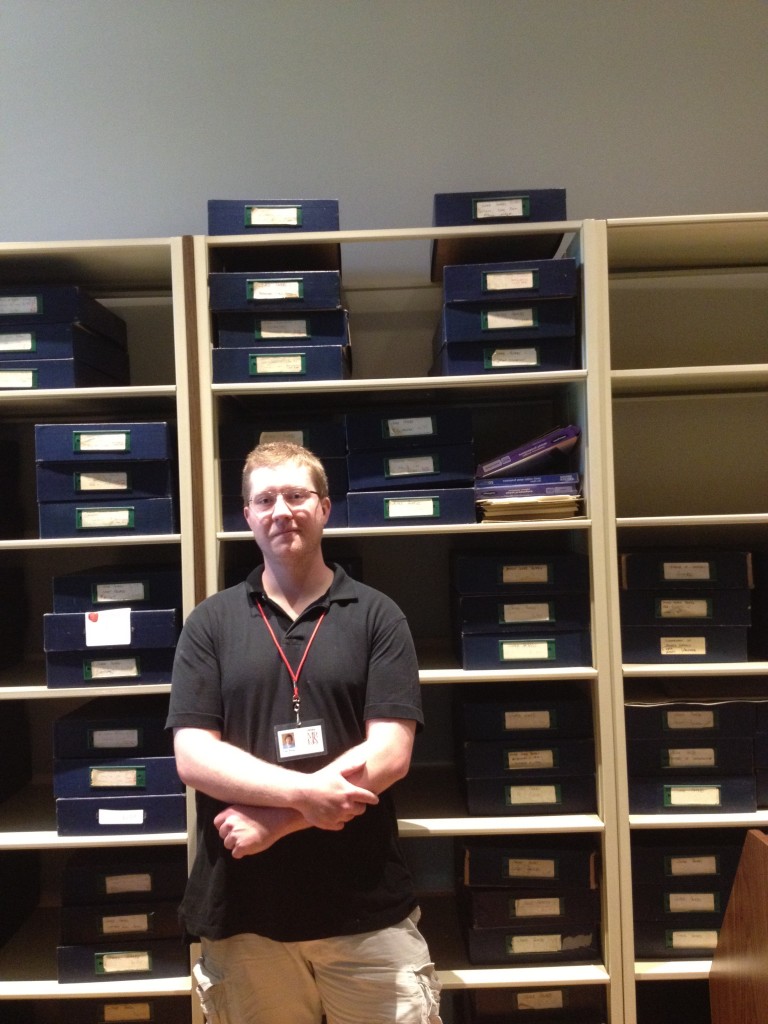Morris A. Soper Papers – Coming Soon! (or 25 years late…)
After a brief hiatus, processing has recommenced full tilt on the Morris Soper Papers. Recent Goucher graduate and MdHS intern Micah Connor is now working on a full time basis processing collection. He joins volunteer Susan Gillett, who has been devoting Saturdays to working on the project for more than a year. We hope to complete the project by the end of 2017.
Today’s post is a reblog of former MdHS archivist Eben Dennis’ piece from December 2013 when he first began processing the papers.
Several months ago while pulling a collection from our sub-basement, or coal cellar, under the south end of the Keyser building here at MdHS, I became intrigued by a box labeled Soper Papers. Most curious were the words “Don’t catalog until 3/88” scrawled on it. Being quite familiar with the fact that most archives—including MdHS—have a large backlog of unprocessed collections, I found this particular note somewhat amusing. I then took a step back and a whole wall of shelving—consisting of nearly 300 boxes—came into focus. The collection was enormous. And though I thought the name Soper sounded vaguely familiar, I couldn’t quite place it.

An image of the remaining batches of Soper Papers from the sub-basement, and the caption reading “Don’t catalog until 3/88.” The 48E number was added during my preliminary survey.
After conducting a quick search of our website I figured out where I had seen the name before. Judge Morris Soper was identified by Baltimore lawyer, author, and professor Larry Gibson when he was helping us identify individuals from photographs of Morgan State University found in the Paul Henderson Collection in 2011. Soper had served as Chairman of Morgan’s Board of Directors for many years, so it was not surprising to find him captured in the photo below.(1) This got me even more curious. Who exactly was Soper? Why was this collection here? Why had it been gathering dust for so many years?

Morgan State’s Board of Trustees meeting with Governor McKeldin ca. 1950. Morris Soper is standing to the right of McKeldin next to Carl Murphy, the owner/editor of The Afro newspaper. Paul Henderson Photo Collection, MdHS, HEN.00.B1-073.
Who Was Morris A. Soper?
Morris Ames Soper’s (1873-1963) judicial service spanned more than a half-century. After being educated in the city schools of Baltimore in the late 19th century, he attended Johns Hopkins University and then went on to law school at the University of Maryland. He was admitted to the Maryland State Bar in 1895 and began practicing law in Baltimore. In 1898 Soper was appointed Assistant State’s Attorney for Baltimore City and was promoted to Assistant United States Attorney for the State of Maryland in 1900.
In 1912 Soper briefly served as president of the Baltimore City Police Board before leaving in an unsuccessful election bid as a GOP candidate for Attorney General of Maryland. He quickly rebounded from his defeat and was appointed Chief Judge of the Supreme Bench of Baltimore City. In 1923 President Harding appointed Soper to the Federal bench where he served as a District Judge, and by 1931 President Hoover had elevated him to the United States Circuit Court of Appeals representing Virginia, West Virginia, North Carolina, South Carolina, and Maryland in the Fourth Circuit. Though he was based in Richmond, Soper kept an office in Baltimore. Judge Soper held this position for 24 years until he entered pseudo-retirement in 1955.(2)
In his many years as a judge, Soper dealt with an enormous number of cases involving the Eighteenth Amendment, which established prohibition. During the Prohibition Era he padlocked over 165 Maryland buildings for violations of the Volstead Act. This came as little surprise as Soper had previously served as attorney for the Baltimore Reform League and was counsel for the Society for the Suppression of Vice earlier in the decade.(3) While serving on the Fourth Circuit, Soper made many rulings on tax cases, labor relations disputes, interstate commerce cases, and cases originating from the Federal Trade Commission and the Security Exchange Commission.

A pencil sketch of Morris A. Soper (1873-1963) by Stirling Hill. Morris A. Soper Papers (MS3121),Box 93E, Maryland Historical Society.
Most notably, Soper worked towards full equality for African-Americans. He viewed equality as “not only a matter of law, but a matter of conscience.” As early as 1937, Soper—from his position as Chairman of the State Commission on Higher Education for Negroes—was urging the Maryland legislature to admit African-Americans to the University of Maryland graduate departments. National attention was focused on Soper when he decided many of the early school desegregation cases that reached the Federal Courts in the wake of Brown vs the Board of Education in 1954. In 1955 Soper handed down the decision that required the University of North Carolina to admit three African-American students into its undergraduate college. The following year he wrote majority opinions on racial integration in Virginia public schools. Judge Soper served for over 30 years on the Board of Trustees at Morgan State College, and was chairman for much of the latter half of his tenure. He is credited as being instrumental in transforming the institution from a private college to a state supported institution.
His last act from the bench was striking down the barriers preventing a young African-American named Henry Gantt from attending the school of architecture at Clemson University. Less than two months later, two days after his 90th birthday, Judge Soper passed away after undergoing minor surgery at Union Memorial Hospital. Among the group of distinguished honorary pallbearers were Governor McKeldin and Attorney General Robert F. Kennedy.
Where did this Collection Come From?
As Judge Soper’s prominence became apparent to me, I quickly made the decision to put this collection at the top of the processing queue. I found some answers about the collections provenance in A Guide to the Preservation of Federal Judges’ Papers published by the Federal Judicial History Office at the Federal Judicial Center in 2009. I was surprised to read that:
“Neither federal statute nor the policies of the Judicial Conference of the United States make any provision for the preservation of federal judges’ papers. Judges’ staffs or the clerks of court cannot determine where the papers go, and the National Archives cannot accept the collections as part of the records of the courts. Nor are court funds available for the preservation of judges’ papers, and the federal records centers do not provide temporary storage of judges’ chambers papers…”
Basically, as is the case with the Soper Papers, the judge’s heirs often end up with the collection of papers, and if the collection isn’t thrown out (yes, this often happens), they often come to local libraries or historical societies.
When the Soper Papers were deeded to MdHS, they came with a 25-year restriction (from the date of his passing), hence the “do not catalog until 1988.” A quarter of a century is a long time for a collection to be forgotten about in a basement. Once it had already sat around for 25 years (1963-1988), it made it easy for it to sit another 25 years on top of that. A combination of the restriction, the location where it was stored, the enormous physical size of the collection, and staff turnover, most likely dissuaded previous archivists from placing the task of processing the papers high on their queues. Being attracted to the bigger, dirtier jobs, and seeing the obvious importance of the subject matter, I was thrilled.
The Pre-processing Survey
The first step was literally schlepping the collection up a treacherous flight of stairs from the basement, and then to the library workroom on the second floor. Because sweaty librarians tend to gross patrons out, I was lucky to have volunteer Tom Pineo to help with the task.
Due to the enormity of the collection and limited workroom space, we’re forced to work in batches, bringing up a few dozen boxes at a time. The next step in getting a handle on a collection of this magnitude is to conduct a pre-processing survey. This is an essential step in establishing the physical and intellectual scope of the collection before you can begin the processing, or arrangement of the papers. The more thorough and complete this survey is, the easier the collection is to process.
Because staff hours are precious (we have 6,000 patron requests a year!), and we have competing responsibilities, I needed to come up with the most efficient way to make this collection available to the public. In archival lingo, the method I have applied is “More Product, Less Process,” or MPLP for short. Though I would love to disappear with this collection into the library’s underbelly for ten years, and emerge triumphantly with an item-level description of 300 perfectly preserved boxes, it isn’t reality. I needed a common sense approach and a little bit of help. So my plan is to go through the collection somewhat quickly, box by box, resisting temptation to process, while I inventory. This inventory consists of detailed notes about subjects, date ranges, notable individuals, and court case files in each box. At the same time it includes preservation notes for the processors, supply estimates, and the intellectual arrangement as each box gets grouped into its appropriate series.(4)
Once I get the approximately 300 boxes described, the processing plan can be implemented. At that point, the help of three graduate interns (pursuing library, archive, or history careers) will be enlisted. These interns will then use the survey and some guidance to give the collection some TLC. They will rehouse the papers in acid free folders, consistently label all the folders and boxes, and comb through the collection in finer detail than my initial survey. In the meantime, I will use my survey as a box level inventory which will be placed in our catalog and made accessible to researchers. Though they may not be able to easily request the exact document they want, they can probably narrow it down to three or four boxes. This way the collection will be quickly accessible, while being processed to the folder level in the meantime. The main logistical problem with this method is that overstuffed boxes may expand into several boxes. Though physical rearrangement of the papers will be kept to a minimum, there are already several instances where material from one box needs to be separated.(5)
At this point I have surveyed the first 120 boxes and many interesting threads and subjects have already emerged. Below I have listed some of the people and subjects that have already made appearances in the collection. (Quick teaser- notable correspondence with Thurgood Marshall, H.L. Mencken, and my favorite Charles Ponzi!) In the coming months stay tuned for more intriguing stories brought to life by this collection. A box level inventory to the Morris Ames Soper Papers (MS 3121), should be available to the public by late summer. (Eben Dennis)
Subjects
People –W. Calvin Chestnutt, August Chissell, Harry S. Cummings, Samuel K. Dennis, Der Doo, Armistead M. Dobie, Leroy Benjamin Frasier Jr, Phillips Lee Goldsborough, Clement Haynesworth, Louise Kerr Hines, Dwight Oliver Wendell Holmes, Howard Jackson, Robert F. Kennedy, Linwood Koger, William Preston Lane, Theodore McKeldin, Thurgood Marshall, H.L. Mencken, Clarence W. Miles, Carl Murphy, Donald Gaines Murray, Harry W. Nice, Emory Niles, Elliott Northcott, Sidney Nyburg, Herbert R. O’Conor, John J. Parker, Orie L. Phillips, Charles Ponzi, James H. Preston, George L. Radcliffe, Albert Ritchie, Simon E. Sobeloff, John O. Spencer, Roszel Thomsen, Millard E. Tydings, Arthur T. Vanderbilt.
Corporate names– American Bar Association, American Sugar Refining Corporation, Baltimore Bar Association, Baltimore and Ohio Railroad, Baltimore Police Department, Baltimore Trust Company, Commission on Higher Education of Negroes in the State of Maryland, Druid Ridge Cemetery Company, Goucher College, Loudon Park Cemetary, Maryland State Bar Association, Morgan State University, Pennsylvania Railroad, Provident Hospital, State Commission on Higher Education for Negroes, United States Court of Appeals for the Fourth Circuit, Wheeling Steel Corporation.
Topics– Civil Rights, Criminal Law, Criminal justice, Interstate Commerce, NAACP vs Harrison, Prohibition, School Desegregation, Steamship accidents, Volstead Act.
Footnotes:
(1) Morgan State even named their library in his honor in 1939.
(2) President Eisenhower allowed Soper to remain serving the courts “from time to time,” which he did until two months from his death at the age of 90 in 1963.
(3) Stay tuned for a future post about this very subject centering around some fascinating correspondence between Soper and H.L. Mencken
(4) A series basically divides the collection into large chunks or groups, similar to the chapters in a book. In the case of the Soper collection there will probably be 3 or 4 series including correspondence (chronological), chamber papers or case files, and subject files (A-Z).
(5) An important principle of archival theory is original order. The collection should reflect the order it was kept in before it came to an archive. In the case of the Soper papers, the material within boxes will be kept in order, but boxes next to each other on the shelf had no rhyme or reason. Occassionally boxes appear to have been arbitrarily combined, in which case effort will be made to place them back in their original context.



